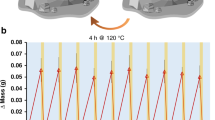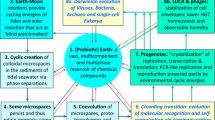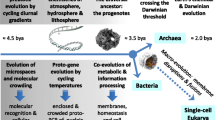Summary
A model is proposed for a prebiotic environment in which concentration, condensation, and chemical evolution of biomolecules could have taken place. The main reactions expected of proteins, nucleic acids, lipids, and some of their precursors in this environment are examined.
The model is based on our previously developed concept of a fluctuating system in which hydration and dehydration processes take place in a cyclic manner. In the present model, however, high concentrations of soluble salts, such as chlorides and sulfates, are taken into account, whereas previously a more or less salt-free system had been assumed. Thus the preponderance of surfaces of soluble salts is implied, even though sparingly soluble minerals, such as clay minerals or quartz, are also present.
During the dehydration stage biomolecules tend to leave the solution and concentrate at certain microenvironments, such as in micelles and aggregates, at the liquid-gas surface and, possibly, at the emerging solid surfaces. Moreover, in these brines, and especially during the last stages of dehydration, high temperatures are attainable, which may enhance certain reactions between the organic molecules, and result in a net increase of condensation over degradation.
In the dehydrated state, solid-state condensation and synthesis reactions are possible in which the surface of soluble salts may serve as a catalyst. Several reports in the literature support this hypothesis. Hydration brings about dissolution of the minerals and redistribution of the biomolecules. In such a system, evolutionary processes like those postulated by White (1980) and by Lahav and White (1980) are possible. Moreover, since several soluble salts of known geological occurrence are optically active in their crystalline state, the involvement of the model system in the selection and evolution of chiral organic compounds should also be considered. In addition, organic molecules in the above microenvironments are also expected to undergo selective interactions based on factors such as molecular pattern and chiral recognition and hydrophobicity. The proposed system emphasizes the need to develop the theoretical background and experimental methods for the study of interactions among biomolecules in the presence of high salt concentrations and solid surfaces of soluble salts, as well as interactions between the biomolecules and these surfaces.
Similar content being viewed by others
References
Arnett EM, Zingg SP (1981) Chiral discrimination in the energetics of ion aggregation. J Am Chem Soc 103:1221–1222
Beck MT (1978) Prebiotic coordination chemistry. The possible role of transition metal complexes in the chemical evolution. In: Siegel H (ed) Metal ions in biological systems. Vol. 7. Marcel Dekker Inc., New York
Bernal JD (1951) The physical basis of life. Routledge and Kegan Paul, London
Bonner WA (1972) Origins of molecular chirality. In: Ponnamperuma C (ed) Exobiology. North Holland, Amsterdam pp 170–234
Bonner WA, Blair NE, Dirbas FM (1981) Experiments on the abiotic amplification of optical activity. Orig Life 11:119–124
Bonora B, Palka G, Jovine R, Miscia S, Caramelli E, Manzoli FA (1981) Interactions among DNA, metallic ions, and lipids. Physiol Chem Phys 13:19–21
Brack A, Spach G (1979) β-structures of polypeptide with L- and D-residues. Part I. Synthesis and conformation studies. J Mol Evol 13:35–46
Brack A, Spach G (1980) β-structures of polypeptides with L- and D-residues. Part III. Experimental evidences of enrichment in enantiomer. J Mol Evol 15:231–238
Brack A, Spach G (1981) Enantiomer enrichment in early peptides. Orig Life 11:135–142
Briggs LI, Pollack HN (1967) Digital model of evaporite sedimentation. Science 155:453–456
Calvin M (1969) Chemical evolution. Oxford University Press, p 169
Chang S, DeMarais D, Mack R, Miller SL, Strathearn G (1982) Prebiotic organic synthesis and the origin of life. In: Schopf JW (ed) Earth's earliest biosphere: Its origin and early evolution. Princeton University Press
Deamer DW, Oró J (1980) Role of lipids in prebiotic structures. J Mol Evol 12:167–175
Dillon LS (1978) The genetic mechanism and the origin of life. Plenum Press, New York London
Drew H, Takano T, Tanaka S, Itakura K, Dickerson RE (1980) High-salt d(CpGpCpG), a left-handed Z'DNA double helix. Nature 280:507–513
Edelhock H, Osborne JC (1976) The thermodynamic basis for the stability of proteins, nucleic acids, and membranes. In: Anfinsen CB et al. (eds) Advances in protein chemistry. Vol. 30. Academic Press, New York
Edinger SE (1973) The growth of gypsum. J Crystal Growth 18:217–224
Edsall JT, Wyman J (1962) Biophysical Chemistry. Vol. 1. Academic Press, New York, p 247
Edsall JT, McKenzie HA (1978) Water and proteins. I. The significance and structure of water, its interaction with electrolytes and nonelectrolytes. Adv Biophys 10:137–207
Farmer VC (1957) Effect of grinding during the preparation of alkali halide disks on the infra-red spectra of hydroxylic compounds. Spectrochim Acta 8:378–389
Flores JJ, Leckie JO (1973) Peptide formation mediated by cyanate. Nature 244:435–437
Friebele E, Shimoyama A, Ponnamperuma C (1981) Possible selective adsorption of enantiomers by Na-montmorillonite. In: Wolman Y (ed) Origin of life. Reidel Pub. Co., Dordrecht Boston, pp 337–346
Fuller WD, Sanchez RA, Orgel LE (1972) Studies in prebiotic synthesis VII. Solid-state synthesis of purine nucleosides. J Mol Evol 1:249–257
Garrels RH (1959) Rates of geochemical reactions at low temperatures and pressures. In: Abelson PH (ed) Research in geochemistry. John Wiley & Sons Inc., New York, p 511
Greenstein P, Winitz M (1961) Chemistry of amino acids. John Wiley & Sons Inc., New York London
Hamabata A, Chang S, Von Hippel PH (1973a) Model studies on the effects of neutral salts on the conformational stability of biological macromolecules. III. Solubility of fatty acids in ionic solutions. Biochemistry 12:1271–1278
Hamabata A, Chang S, Von Hippel PH (1973b) Model studies on the effects of neutral salts on the conformational stability of biological macromolecules. IV. Properties of fatty acids amide micelles. Biochemistry 12:1278–1282
Hamaguchi K, Geiduschek EP (1962) The effect of electrolytes on the stability of the deoxyribonucleate helix. J Am Chem Soc 84:1329–1338
Hawker JR Jr, Oró J (1981) Cynamide mediated syntheses of LEU, ALA, and PHE peptides under plausible primitive Earth conditions. In: Wolman Y (ed) Origin of life. Reidel Pub. Co., Dordrecht Boston, pp 225–232
Holland HD (1974) Aspects of the geological history of seawater. In: Oró et al. (eds) Cosmochemical evolution and the origins of life. D. Reidel Pub. Co., Dordrecht Holland, Boston
Hubbard JS, Hardy JP, Voecks GE (1973) Photocatalytic synthesis of organic compounds from CO and H2O: Involvement of surfaces in the formation and stabilization of products. J Mol Evol 2:149–166
Jones MN (1975) Biological interfaces. An introduction to the surface and colloidal science of biochemical and biological systems. Elsevier, Amsterdam
Kim YH (1981) Stereoselective interactions of small biological molecules. In: Wolman Y (ed) Origin of life. Reidel Pub. Co., Dordrecht Boston, pp 331–336
Lacey JC Jr, Mullins DW (1974) Isolated microsystems in evolution. Dose K et al. (eds) The origin of life and evolutionary biochemistry. Plenum Press, New York London
Lahav N, Chang S (1976) The possible role of solid surface area in condensation reactions during chemical evolution. Reevaluation, J Mol Evol 8:357–380
Lahav N, White DH (1980) A possible role of fluctuating clay-water-systems in the production of ordered prebiotic oligomers. J Mol Evol 16:11–21
Lahav N, White DH, Chang S (1978) Peptide formation in the prebiotic era: Thermal condensation of glycine in fluctuating clay environments. Science 201:67–69
Langer AM (1978) Crystal faces and cleavage planes in quartz as templates in biological processes. Quart Rev Biophys 11:543–575
Lapanje S (178) Physicochemical aspects of protein denaturation. John Wiley & Sons, New York, p 217
Lasaga AC, Holland HD, Dwyer MJ (1971) Primordial oil slick. Science 174:53–55
Leach WM, Nooner DW, Oró J (1978) Abiotic synthesis of fatty acids. Origin of life. Center for Academic Publication Japan/Japan Scientific Societies Press, pp 113–122
Lohrmann R (1975) Formation of nucleoside 5′-polyphosphates from nucleosides and trimetaphophates. J Mol Evol 6:237–252
Lohrmann R (1977) Formation of nucleoside 5′-phosphoramidates under potentially prebiotic conditions. J Mol Evol 10:137–154
Lohrmann R, Ranganathan R, Sawai H, Orgel LE (1975) Prebiotic peptide formation in the solid state. I. Reaction of benzoate ions. J Mol Evol 5:57–73
Lohrmann R, Bridson PK, Orgel LE (1980) Efficient metal-ion catalyzed template-directed oligonucleotide synthesis. Science 208:1464–1465
Lohrmann R, Orgel LE (1973) Prebiotic activation processes. Nature 244:418–420
Lohrmann R, Orgel LE (1978) Formation of P1,P2-dinucleoside 5′-pyrophsophates under potentially prebiological conditions. J Mol Evol 11:17–23
Long FA, McDevit WF (1952) Activity coefficients of nonelectrolyte solutes in aqueous salt solutions. Chem Rev 5:119–169
Longchambon ML (1922) Recherches experimentales sur le pouvoir des corps cristallisis. Bulletin de la Société Francaise de Mineralogie 45:161–252
Lowry TM (1964) Optical rotatory power. Dover Pub. Inc., New York, pp 337–346
MacElroy RD, Coeckelenbergh Y, Rein R (1978) An approach to the origin of self-replicating systems. I. Intermolecular interactions. In: Noda H (ed) Origin of life. Center for Acad Pub Japan/Japan Sci Soc Press, pp 249–254
McCartney ER, Alexander AE (1958) The effect of additives upon the process of crystallization. I. Crystallization of calcium sulfate. J Coll Sci 13:383–396
Melius P (1979) Non-random non-ribosomal assembly of amino acids in proteins and protenoids. BioSystems 11:125–132
Nandi PK, Robinson DR (1972a) The effect of salt on the free energy of the peptide group. J Am Chem Soc 94:1299–1308
Nandi PK, Robinson DR (1972b) The effect of salts on the free energies of nonpolar groups in model peptides. J Am Chem Soc 94:1308–1315
Nissenbaum A, Kenyon DH, Oró J (1975) On the possible role of organic melanoidin polymers as matrices for prebiotic activity. J Mol Evol 6:253–270
Nordén B (1978) The asymmetry of life. J Mol Evol 11:313–332
Orgel LE, Lohrmann R (1974) Prebiotic chemistry and nucleic acid replication. Acc Chem Res 7:368–377
Ponnamperuma C, Chang S (1971) The role of phosphates in chemical evolution. In: Buvet R, Ponnamperuma C (eds) Chemical evolution and the origin of life. North Holland Pub. Co.
Rao M, Odom DG, Oró J (1980) Clays in prebiotic chemistry. J Mol Evol 15:317–331
Rishpon J, O'Hara PJ, Lahav N, Lawless JG (1982) Interaction between ATP, metal ions, glycine, and several minerals. J Mol Evol (in press)
Robinson DR, Jencks WP (1965) The effect of compounds of urea-guanidinium class on the activity coefficient of acetyl-tetraglycine ethyl ester and related compounds. J Am Chem Soc 87:2462–2469
Robinson DR, Grant ME (1966) The effects of aqueous salt solutions on the activity coefficients of purine and pyrimidine bases and their relation to the denaturation of deoxyribonucleic acid by salts. J Biol Chem 241:4030–4042
Sawai H, Orgel LE (1975) Prebiotic peptide-formation in the solid state. III. J Mol Evol 6:185–197
Sawai H, Lohrmann R, Orgel LE (1975) Prebiotic peptide-formation in the solid state. II. J Mol Evol 6:165–181
Schrauzer GN, Guth TD, Palmer MR (1979) Nitrogen reducing solar cells. In: Hautala RR, King RB, Kutal C (eds) Solar energy: Chemical conversion and storage. The Humana Press, Clifton New York, 261–269
Schuster P (1981) Prebiotic evolution. In: Gutfreund H (ed) Biochemical evolution. Cambridge University Press, Cambridge, pp 15–87
Scott JE (1979) Hydrated electrons and prebiotic evolution. J Theor Biol 81:19–27
Snyder WD, Fox SE (1975) A model for the origin of stable protecells in a primitive alkaline ocean. BioSystems 7:222–229
Spach G, Brack A (1979) β-structures of polypeptides with L- and D-residues. Part II. Statistical analysis and enrichment in enantiomer. J Mol Evol 13:47–56
Stilwell W (1977) On the origin of phosphorylation. J Theor Biol 65:479–497
Stilwell W (1980) Facilitated diffusion as a method for selective accumulation of materials from the primordial ocean by lipid-vesicle protocell. Orig life 10:277–292
Suess E (1970) Interaction of organic compounds with calcium carbonate. I. Association phenomena and geochemical implications. Geochim Gosmochim Acta 34:157–168
Tanford C (1980) The hydrophobic effect: Formation of micelles and biological membranes. John Wiley & Sons, New York
Ts'o POP (1974) Bases, nucleosides, and nucleotides. In: Ts'o POP (ed) Basic principles in nucleic acid chemistry. Vol. I. Academic Press, New York
Ts'o POP, Melvin IS, Olson AC (1963) Interaction and association of bases and nucleosides in aqueous solutions. J Am Chem Soc 85:1289–1296
Verlander MS, Lohrmann R, Orgel LE (1973) Catalysts for the self-polimerization of adenosine cyclic 2′, 3′-phosphate. J Mol Evol 2:303–316
Vol'kenshtein MV (1970) Molecules and life. An introduction to molecular biology. Plenum Press, New York London
Von Hippel PH, Schleich T (1969) The effect of neutral salts on the structure and conformational stability of macromolecules in solution. In: Timasheff SN, Fasman GD (eds) Structure and stability of biological macromolecules. Marcel Decker Inc., New York
Weber AL, Caroon JM, Warden JT, Lemmon RM, Calvin M (1977) Simultaneous peptide and oligonucleotide formation in mixtures of amino acids, nucleoside triphosphate, imidazole, and magnesium ion. BioSystems 8:277–286
Weber AL, Miller SL (1981) Reasons for the occurrence of the twenty coded protein amino acids. J Mol Evol 17:273–284
White DH (1980) A theory for the origin of a self-replicating chemical system. I. Natural selection of the Autogen from short, random oligomers. J Mol Evol 16:121–147
Yamagishi A, Soma M (1981) Optical resolution of metal chelates by use of adsorption on a colloidal clay. J Am Chem Soc 103:4640–4642
Yariv S (1976) Organophilic pores as proposed primary migration media for hydrocarbons in argillaceous rocks. Clay Science 5:19–29
Author information
Authors and Affiliations
Rights and permissions
About this article
Cite this article
Lahav, N., Chang, S. The possible role of soluble salts in chemical evolution. J Mol Evol 19, 36–46 (1982). https://doi.org/10.1007/BF02100222
Received:
Revised:
Issue Date:
DOI: https://doi.org/10.1007/BF02100222




